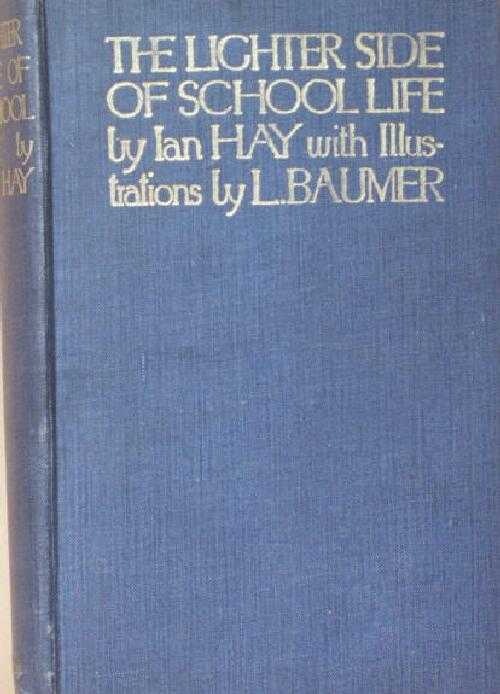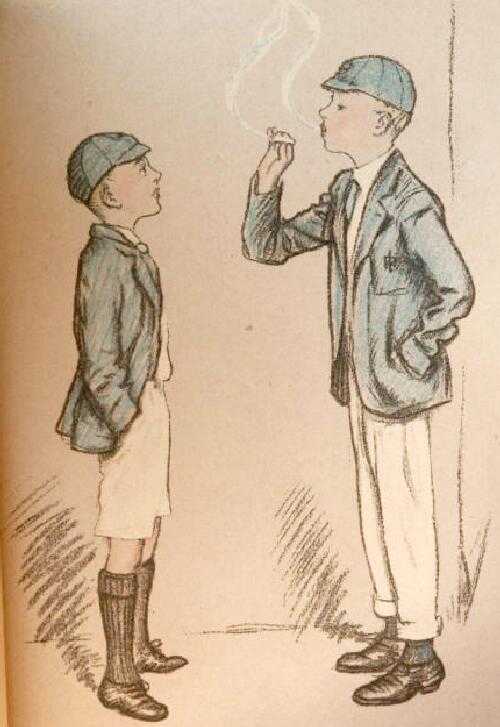
English Children's Literature: Individual School Story Books--The Lighter Side of School Life (1915)

Figure 1.--Although the book is full of fascinating illustrations, there was no cover illustration. I'm not sure about the book jacket. Click on the image to see another illustration. The caption is, "The luncheon interval. Portait of genteleman and ????". Images courtesy of the AM collection.
|
Another fascinating book is The Lighter Side of School Life by Ian Hay. It was published by T. N. Foulis. I'm not sure when it was originally printed, but the second printing was in 1915. It was printed in Edinburgh, Scotland, but I don't notice any especially Scottish conent. It's quite a fascinating book by the way it is constructed. I speak under correction but it seems the book was not wholly bound by machine. It has high quality paper but is not uniformly cut and it appears the guillotine used to cut the pages was not always sharp. The illustrations are by Lewis Baumer are wonderful and I think of great interest. The illustrations are printed on a different type of paper compared to the text and are covered by a preceding page of a heavy duty type of rice paper. What makes the illustrations especially delightful is that they are coloured in by a pastel type crayon. Besides still looking remarkably fresh, the illustrations look like the original art but no doubt is the type of print used. The use of crayon seem to give the art a contemporary type of look. Note the illustration where pink is used.
Author
Another fascinating book is The Lighter Side of School Life by Ian Hay. We have no information about him a this time.
Publisher
It was published by T. N. Foulis. I speak under correction but it seems the book was not wholly bound by machine. It has high quality paper but is not uniformly cut and it appears the guillotine used to cut the pages was not always sharp. As mentioned in my article, the way the book is bound is distinctive and perhaps T.N. Foulis was a small (?) independent publisher located in Scotland.
Baumer was an established illustrator and cartoonist with a consideranle reputation. He was born in St. John's Wood, London during 1870. He was educated at South Kensington School and the Royal Academy School. His early work consisted primarily on water-color, pastel and oil portraits. Baumer during World War I contributed his destinctive illustrations to several periodical magazines, usualy as often quite biting satirical cartoons. The most important publicztion he contributed to was Punch Magazine. He also contributed to several lesser known publications, including The Bystander, The Idler, The Illustrated Bits, The London Magazine, The Strand Magazine and The Royal Magazine. Baumer also illustrated several books. These included The Perfect Gentleman (1912), Vanity Fair (1913), The Complete Sportsman (1914), The Shallow End (1924), Silver and Gold (1925) and Bright Young Things (1928). We are unsure to what extent he illustrated children's books or school stories. We do know of one children's book that he helped illustrate, E. Nesbit's New Treasure Seekers. The only school book that we know Baumer illustrated was The Lighter Side of School Life. Ther may well have been more. Baumer died in 1963.
Color Printing
The illustrations are printed on a different type of paper compared to the text and are covered by a preceding page of a heavy duty type of rice paper. What makes the illustrations especially delightful is that they are coloured in by a pastel type crayon. Besides still looking remarkably fresh, the illustrations look like the original art but no doubt is the type of print used. The use of crayon seem to give the art a contemporary type of look. Note the illustration where pink is used.

Figure 2.--The caption read, "The Daredevil". Click on the image to see another illustration. The caption is, "The Nipper." Images courtesy of the AM collection.
|
Chronology
The book was published in 1914 and the second printing is 1915.
Scotland
It was printed in Edinburgh, Scotland, but I don't notice any especially Scottish conent. It's quite a fascinating book by the way it is constructed. However at the back of the book, the publisher, T.N. Foulis, has a list of advertisements of the range of books it sells which are put under categories. Some are:
'Books to Entertain', 'Some English Books', 'Some Scottish Books', 'Presentation Volumes' and 'Out-Door Volumes'. It also advertises booklets for sale written in French and German.
Contents
The book's list of contents are (amongst others) : 'The Headmaster', 'The Housemaster', 'Some Form-Masters' and 'Boys'. The chapters have a lighthearted look and anecdotes on the trial and tribulations of public school life. As regards to the contents of the book, the are not really stories but rather tongue in cheek
character sketches and profiles of all those that make up a public school. The author relates to specific personalities (from the headmaster to the boys) and at times their idiosyncric, noteworthy character traits i.e the perfectionist, the 'organizer', the zealous sportsman, the prankster and suchlike. Here, is his description of 'The Nippers': "A small boy is as different from a middle sized boy as chalk from cheese. He possesses none of the latter's curious dignity and self-conscciousness. He has the instincts of the puppy, and appreciates being treated as such. That is to say,
he is physically incapable of sitting still for more than fifteen minutes at a time; he is never happy except in the company of a drove of other small boys; and he is infinitely more amenable to the 'fortier in re' than to the 'suaviler in modo' where the
enforcement of discipline is concerned. Above all, he would rather have his head smacked than be ignored." Of course there are a legion of nicknames given to the headmasters, form- masters and boys alike. i.e. "the Doctor' for a headmaster, 'Sqeaker', 'Tadpole' for a small boy, 'Flabb', a conscientious prefect and so on.
Clothing
The Lewis Baumer illustrations depict the school boys in essentiallt the same uniform, cap, blazr and long and short pants. The only basic difference is the color of the dcap and blazer. I'm not sure to what extent this was planned by Naumer or dertermined by the colorist.
HBC

Navigate the HBC literary pages' Historical Clothing Web Site:
[Return to the Main English individual school book page]
[Return to the Main children's literary page]
[Return to the Main English literary page]
Navigate the Boys' Historical Clothing Web Site:
[Introduction]
[Activities]
[Biographies]
[Chronology]
[Clothing styles]
[Countries]
[Literary]
[Bibliographies]
[Contributions]
[FAQs]
[Glossaries]
[Satellite sites]
[Tools]
[Boys' Clothing Home]
Created: April 5, 2003
Last updated: April 5, 2003




